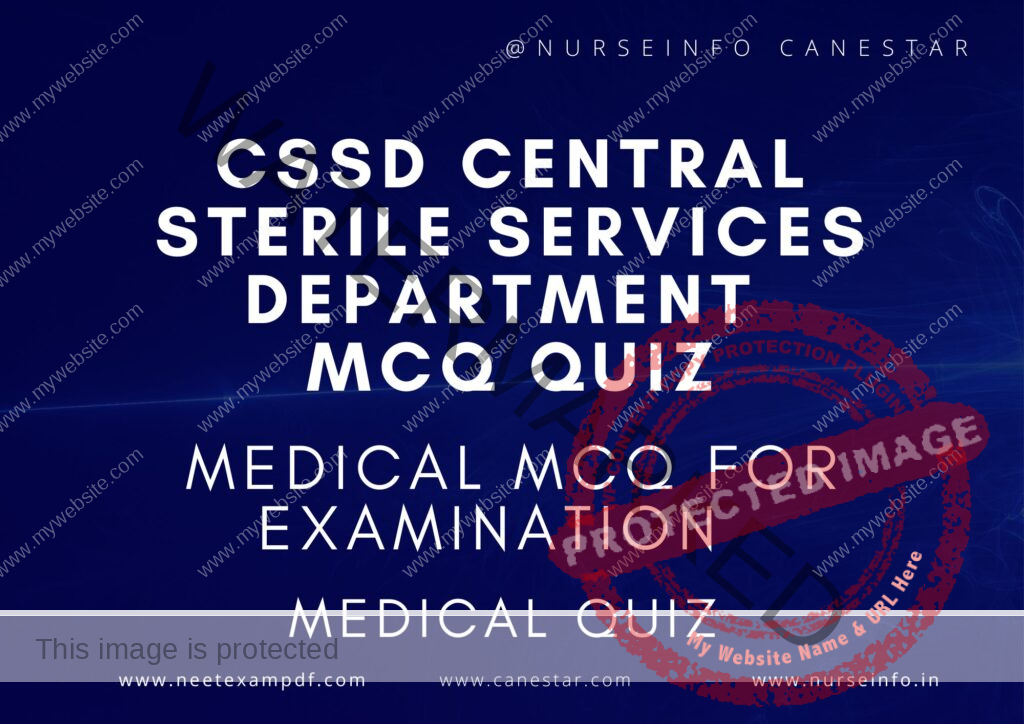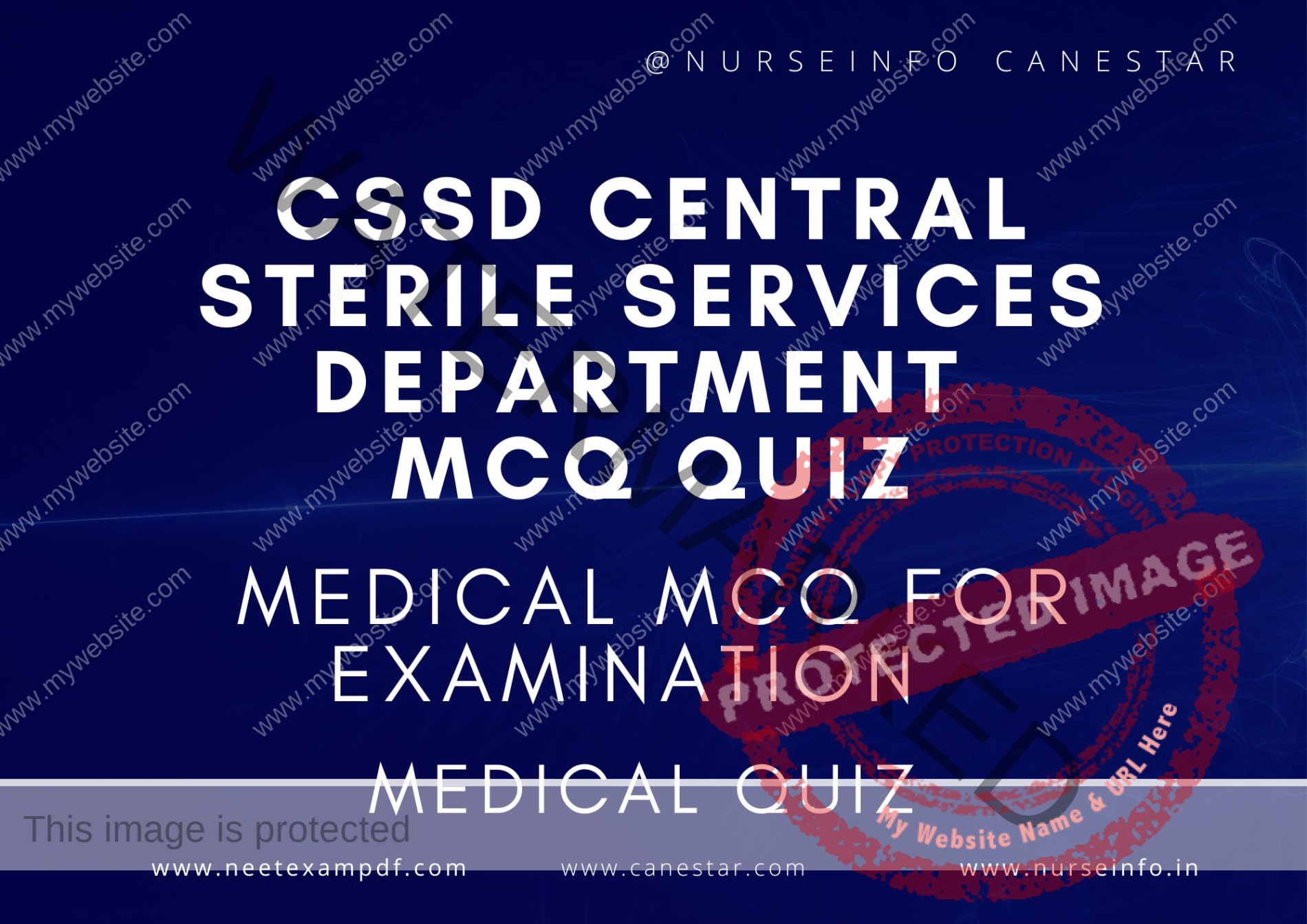MULTIPLE CHOICE QUESTIONS ON CSSD QUIZ – MCQS WITH RATIONALE ANSWER – CENTRAL STERILE SERVICES DEPARTMENT MCQ QUESTIONS WITH RATIONALE
MCQ FOR CENTRAL STERILE SERVICES DEPARTMENT CSSD QUIZ
These mcqs are prepared exclusively for medical professionals for exam preparation. MCQ is helpful to remember the concept on CSSD mcq quiz. This multiple choice questions are helpful for preparation for DHA, PROMETRIC, MOH, HAAD, NCLEX, Medical, NEET and Nursing EXAMINATION
CSSD CENTRAL STERILE SERVICES DEPARTMENT MCQ QUIZ
What is the primary purpose of the Central Sterile Services Department (CSSD)?
A) To manage patient records
B) To sterilize medical equipment and supplies
C) To provide dietary services
D) To offer patient counseling
Answer: B) To sterilize medical equipment and supplies
Rationale: The CSSD is responsible for cleaning, disinfecting, and sterilizing medical instruments and supplies to ensure they are safe for patient use.
Which of the following is a common method of sterilization used in the CSSD?
A) Autoclaving
B) Freezing
C) Radiation therapy
D) Ultrasonography
Answer: A) Autoclaving
Rationale: Autoclaving uses steam under pressure to sterilize medical instruments and is a standard method used in the CSSD.
What is the recommended temperature and pressure for steam sterilization in an autoclave?
A) 121°C at 15 psi
B) 100°C at 10 psi
C) 150°C at 20 psi
D) 200°C at 25 psi
Answer: A) 121°C at 15 psi
Rationale: The standard condition for steam sterilization is 121°C (250°F) at 15 psi (pounds per square inch) for a specified time.
Which indicator is used to verify that an autoclave cycle has successfully sterilized instruments?
A) Chemical indicator
B) Biological indicator
C) Mechanical indicator
D) All of the above
Answer: D) All of the above
Rationale: Chemical, biological, and mechanical indicators are all used to ensure the effectiveness of the sterilization process.
What is the purpose of a biological indicator in sterilization?
A) To monitor temperature
B) To ensure sterility by using spores
C) To record the sterilization cycle
D) To disinfect surfaces
Answer: B) To ensure sterility by using spores
Rationale: Biological indicators use spores that are highly resistant to sterilization processes, providing a reliable method to confirm the effectiveness of the sterilization cycle.
Which of the following is a high-level disinfectant commonly used in CSSD?
A) Alcohol
B) Glutaraldehyde
C) Chlorhexidine
D) Hydrogen peroxide
Answer: B) Glutaraldehyde
Rationale: Glutaraldehyde is a high-level disinfectant effective against a wide range of microorganisms and is commonly used for sterilizing medical equipment.
What is the role of ultrasonic cleaners in the CSSD?
A) Sterilize instruments
B) Remove debris and contaminants
C) Store sterile equipment
D) Label sterilized items
Answer: B) Remove debris and contaminants
Rationale: Ultrasonic cleaners use high-frequency sound waves to remove debris and contaminants from instruments before sterilization.
Which of the following best describes “terminal sterilization”?
A) Sterilizing equipment at the point of use
B) The final step in the sterilization process
C) Using ultraviolet light for sterilization
D) Packaging instruments for sterilization
Answer: B) The final step in the sterilization process
Rationale: Terminal sterilization refers to the final step where items are sterilized in their final packaging, ready for use.
What is the main advantage of using ethylene oxide (EtO) for sterilization?
A) Rapid process
B) No need for special ventilation
C) Effective for heat-sensitive items
D) Low cost
Answer: C) Effective for heat-sensitive items
Rationale: Ethylene oxide is a low-temperature sterilization method suitable for heat-sensitive medical equipment.
Which personal protective equipment (PPE) is essential for staff working in the CSSD?
A) Surgical masks
B) Sterile gloves
C) Gowns
D) All of the above
Answer: D) All of the above
Rationale: Staff in the CSSD must wear appropriate PPE, including masks, gloves, and gowns, to protect themselves and maintain a sterile environment.
What is the purpose of using a Bowie-Dick test in the CSSD?
A) To test the effectiveness of chemical indicators
B) To monitor the performance of vacuum-assisted autoclaves
C) To check for biological contamination
D) To clean instruments before sterilization
Answer: B) To monitor the performance of vacuum-assisted autoclaves
Rationale: The Bowie-Dick test is used to check the effectiveness of the vacuum system in pre-vacuum autoclaves, ensuring proper air removal and steam penetration.
Which sterilization method uses a combination of hydrogen peroxide and low-temperature plasma?
A) Steam sterilization
B) Ethylene oxide sterilization
C) Plasma sterilization
D) Dry heat sterilization
Answer: C) Plasma sterilization
Rationale: Plasma sterilization uses hydrogen peroxide vapor and low-temperature plasma to sterilize heat-sensitive medical instruments.
What is the primary function of a washer-disinfector in the CSSD?
A) Sterilize instruments
B) Disinfect and clean instruments
C) Store sterile supplies
D) Test the sterility of instruments
Answer: B) Disinfect and clean instruments
Rationale: A washer-disinfector automates the process of cleaning and disinfecting instruments before they are sterilized.
What is the standard duration for a flash sterilization cycle?
A) 1 minute
B) 3 minutes
C) 10 minutes
D) 30 minutes
Answer: B) 3 minutes
Rationale: Flash sterilization, used for immediate-use sterilization, typically takes around 3 minutes for unwrapped instruments at high temperatures.
What is the purpose of wrapping instruments before sterilization?
A) To identify the instruments
B) To protect instruments during storage
C) To enhance the sterilization process
D) All of the above
Answer: D) All of the above
Rationale: Wrapping instruments protects them from contamination, helps identify them, and ensures they remain sterile until use.
Which type of water is recommended for use in autoclaves to prevent mineral buildup?
A) Tap water
B) Distilled water
C) Spring water
D) Bottled water
Answer: B) Distilled water
Rationale: Distilled water is free from minerals and impurities that could cause buildup and damage the autoclave.
What is the main purpose of a decontamination area in the CSSD?
A) Sterilize instruments
B) Pack instruments for sterilization
C) Clean and remove contaminants from instruments
D) Store sterile instruments
Answer: C) Clean and remove contaminants from instruments
Rationale: The decontamination area is where instruments are cleaned and contaminants are removed before further processing.
Which gas is commonly used in gas plasma sterilization?
A) Nitrogen
B) Oxygen
C) Hydrogen peroxide
D) Carbon dioxide
Answer: C) Hydrogen peroxide
Rationale: Hydrogen peroxide is the gas used in gas plasma sterilization, providing an effective low-temperature sterilization method.
What is the appropriate action if a biological indicator shows a positive result after sterilization?
A) Release the instruments for use
B) Reprocess the instruments immediately
C) Ignore the result
D) Send the instruments for repair
Answer: B) Reprocess the instruments immediately
Rationale: A positive result indicates that sterilization was not effective, and the instruments must be reprocessed to ensure sterility.
Why is it important to document sterilization cycles in the CSSD?
A) To track inventory
B) To ensure compliance with regulations
C) To provide proof of sterility
D) All of the above
Answer: D) All of the above
Rationale: Documenting sterilization cycles ensures compliance with regulatory standards, tracks inventory, and provides proof that instruments have been properly sterilized.


